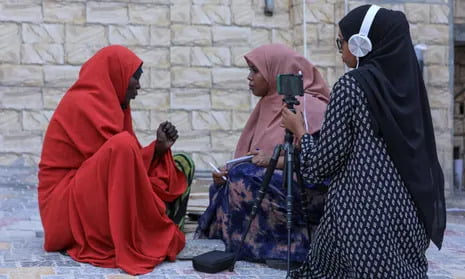10 ways to Protect Women Journalists in terror zone while Counting violent Extremisms

Another day, another story for bilan, as two of its journalists interview a woman on the streets of mogadishu, somalia. Photograph Hasan Ali Elmi Afpgetty images.
Terror arrears are often highly dangerous and volatile, and journalists, especially women, face significant risks while reporting on extremist activities and their impact on communities protecting women journalists in terror zones while they are countering violent extremism requires a comprehensive and multi-faceted approach.
In this article, The Bridge Magazine is going to share ten strategies to enhance the safety and protection of women journalists in such areas.
Advocacy and Awareness
In the Interview with Francis Kalisa, a Freelancer reporter pointed out raising awareness about the importance of protecting journalists, particularly women, in terror zones. Engaging with governments, NGOs, and international bodies to advocate for their safety and press for accountability in case of attacks or threats is the key.
Security Training and Support
Kalisa pointed out that another tip is to provide extensive security training to women journalists, covering topics such as situational awareness, personal safety, conflict reporting, digital security, and first aid.
“Ensure they have access to personal protective equipment and have a reliable means of communication,” he added
Thorough Risk Assessment
He pointed out that every media houses, before deploying journalists to terror zones, have to conduct a comprehensive risk assessment to identify potential threats and challenges.
“This assessment should include an evaluation of the security situation, potential sources of danger, and risks specific to women,” Kalisa explained
Hostile Environment Training
Offer specialized hostile environment training for journalists working in conflict zones.
Kalisa, highlighted that this training should focus on how to handle dangerous situations, avoid becoming targets, and respond to emergencies.
Access to Safety Equipment and Resources
In terms of their protection, there is a need to equip women journalists with safety gear such as bulletproof vests, helmets, and first-aid kits.
Additionally, Kalisa mentioned that there is a need to ensure that they have access to reliable transportation and safe accommodations.
Psychological Support
Kalisa pointed out that like their male counterpart, women in such areas, are exposed to trauma and violence that can have a severe impact on journalists’ mental health and it is essential to offer psychological support services and resources to help them cope with stress and trauma.
Secure Digital Communication
He pointed out that, training journalists in secure communication practices and providing them with coded devices for transmitting sensitive information.
Monitoring and Reporting
According to Kalisa, there is a need to monitor and document incidents of violence or harassment against women journalists in terror zones.
“Reporting such incidents to relevant authorities and international organizations can lead to increased protection and support,” he added
Local Contacts and Support
Establish strong connections with local journalists and fixers who are familiar with the region. They can provide valuable insights, guidance, and assistance navigating dangerous areas.
Gender-sensitive Approaches
Kalisa said that it is very important to recognize that women journalists may face unique challenges due to their gender, and implement gender-sensitive policies and practices along with providing a safe space for them to discuss concerns and support each other.
“It is essential to value and safeguard their contributions to countering violent extremism while ensuring their safety and well-being in challenging environments,” he added
Aurore Teta Ufitiwabo

